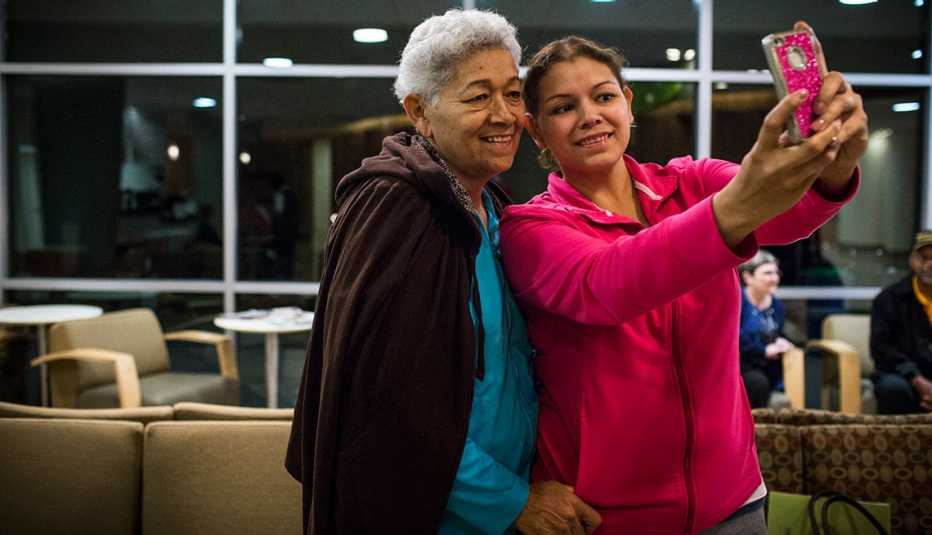AARP Hearing Center
Two Marthas, One Kidney: When her mother's only kidney started to fail, Marthita Cosgalla didn't think twice about donating one of hers
On a sunny afternoon in Calexico, California, the most consequential journey of Martha Romo's life is about to begin. All day, her lime-green-painted apartment has been crammed with friends, neighbors and relatives. A few family members will accompany her; the other guests are here to say adios and buena suerte (good luck). Martha and her daughter — also named Martha — flit about the living room, schmoozing and laughing. You'd never guess that the elder Martha is slowly dying, that Marthita (as the younger one is nicknamed) is gambling her own life to save her mother's, or that each will face a surgeon's knife the next morning.
Despite their age gap — Martha is now 58, while Marthita is 33 — the resemblance between the two women is striking: Both are statuesque, with curly hair and heart-shaped faces. Both also seem astonishingly composed. "I'm not afraid," Martha insists in Spanish. "I'm positive that everything is going to work out fine." Marthita, who works as a customs-broker supervisor, echoes her in softly accented English: "I don't feel nervous. I'm excited." Only a flicker of tension betrays the effort behind their cheer.


In the parking lot, the men in the family are less stoic as they pack a compact car with suitcases. "Of course I'm a little scared; it's natural," says Marthita's husband, Christian Cosgalla. Adds Martha's gray-mustached spouse, Hector Romo: "Every time I think of my wife, I think, Ai, my daughter! And every time I think of my daughter, I think, Ai, my wife!"
The source of his anxiety first revealed itself in 2007, while Marthita and Christian were on their honeymoon. Martha awoke at 4 a.m. to find her nose spouting blood, and nothing she or Hector could do would make it stop. At the local ER, doctors told Martha that the gusher had been caused by a spike in blood pressure, probably triggered by the stress of hosting a wedding with 230 guests. Later, however, her physician ordered tests to check for a deeper problem. Martha was stunned when an X-ray showed she'd been born with just one kidney.
The organ was functioning well, and for six years she carried on with her usual energy, juggling her jobs as a playground aide at a Catholic school and a cook at a Pizza Hut, chasing after her two grandchildren, and dancing at any fiesta where a good grupo de banda was playing. Gradually, however, her lone kidney began to wear out. By August 2013, her levels of creatinine (a waste product produced by muscle and excreted by the kidneys) were soaring, a telltale sign of renal failure.
Martha was placed on hemodialysis, a procedure in which the patient's blood is filtered through a machine that cleanses it of metabolic garbage and excess sodium, potassium and water. Three mornings a week, three hours at a stretch, she sat tethered to the device at a local clinic. The sessions were physically exhausting, and her left arm — where technicians had installed a port called a fistula — was perpetually bruised and painful. She was forced to quit working and go on disability. To keep her blood chemistry balanced, she had to eat a diet low in salt, potassium and phosphorous; foods she was advised to avoid included bananas, beans, tomatoes and cheese. For a woman who relished the cuisine of her native Mexico, and who loved to prepare it for others, those were hard things to give up. She even had to drink water sparingly: Too much would cause excess fluid in the heart, lungs and ankles.


Dialysis can be invaluable in the short term, but its drawbacks go beyond discomfort. Because the process is less efficient at removing waste than an actual kidney, and can cause side effects such as vascular disease and infections, the average life expectancy for patients is five to 10 years. Martha's doctors urged her to consider a transplant, which can extend life another 10 to 20 years.
She and her family made a pilgrimage to Sharp Memorial Hospital in San Diego, 120 miles to the west, whose transplant center is rated among the best in the nation. Specialists there told her she had two options: Go on a waiting list for a cadaver organ, or find someone willing to become a living donor.
Marthita immediately volunteered. An only child, she was born after her mother lost two previous babies — one in a miscarriage, the other a few hours after birth — and spent her third pregnancy on bed rest. "My mom is my best friend," she says. "I owe her everything. I wanted to give her back what she's given me." The two women began undergoing tests to ensure that their blood types were compatible and that they were physically and emotionally capable of enduring the operation.
And now, at 3 p.m. on a Tuesday in June, it's time to hit the road. The well-wishers embrace Martha and Marthita, some making the sign of the cross on the pair's foreheads; Marthita's young daughters, Paulina and Luciana, cry as they hug Mami and Abuelita goodbye. Christian takes the wheel, and the other travelers — Martha, Marthita, Hector and Martha's sister Olga — climb into the car. They reach San Diego by dinnertime, and after a stop at a Chinese buffet, the five of them check into a hotel room. No one sleeps much. Instead, they talk and tell jokes, warding off one another's fears until the alarm clock rings.



































































More on Health
Easy, Enjoyable Ways to Boost Heart Health and Lower Blood Pressure
How just stretching, taking baths or enjoying your coffee could lower your risk of heart attack and stroke